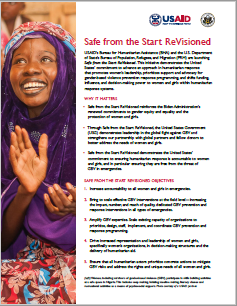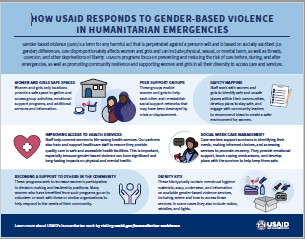Safe From the Start ReVisioned
Women, including survivors of gender-based violence (GBV), participate in skills building activities at a safe space in Nigeria. This includes soap making, knitting, vaseline making, literacy classes and recreational activities as a means of psychosocial support. Photo courtesy of a USAID partner.
Safe from the Start ReVisioned demonstrates the United States’ commitment to advance an approach in humanitarian response that promotes women's leadership, prioritizes support and advocacy for gender-based violence (GBV) prevention and survivor-centered response programming, and shifts funding, influence, and decision-making power to women and girls, in all their diversity, within humanitarian response systems.
Too often, GBV is recognized as a problem only after major response efforts are underway. Despite an existing set of global policies, best practices, and guidelines to prevent and respond to GBV in humanitarian settings, time and again international response efforts have fallen short of meeting established standards in emergencies. In 2013, the U.S. Agency for International Development’s Bureau for Humanitarian Assistance (BHA) – then known as the Office of U.S. Foreign Disaster Assistance – and the U.S. Department of State’s Bureau of Population, Refugees and Migration (PRM) jointly developed the Safe from the Start initiative to mobilize the humanitarian community to take preventive measures and ensure that quality services are available for survivors from the onset of an emergency or crisis.
Since its launch in 2013, the original initiative has galvanized global recognition of GBV programming as an essential, life-saving intervention from the onset of every humanitarian response. Safe from the Start has also directed substantial resources to prevent and respond to GBV. From Fiscal Year 2013-2023, the United States provided more than $221 million in funding toward Safe from the Start through the joint efforts of BHA and PRM. Data and insights collected across Safe from the Start programs have strengthened the collective knowledge of what works in GBV prevention and response programming, and have offered new guidance and tools for sector practitioners. In addition, Safe from the Start investments at major international humanitarian agencies addressed a critical gap in humanitarian emergencies by stimulating institutional change at the headquarters level. This institutional change has, in turn, led to increased capacity of these organizations, their local partners, and national staff to reduce or mitigate GBV risks and provide services for survivors.
In early 2021, BHA and PRM took stock of the significant progress made by Safe from the Start and developed a new more ambitious framework. The output - Safe from the Start ReVisioned - is an even bolder step forward.
The overarching goal of Safe from the Start ReVisioned is that all individuals, specifically women and girls, are free from all forms and threats of GBV in emergencies. Safe from the Start ReVisioned calls on the humanitarian community to not only add to, but change, conventional humanitarian response. This new iteration further focuses on improving and expanding GBV prevention, risk mitigation, and response efforts and expertise – shifting power to crisis-affected women and girls and recognizing them as experts, providers, and leaders. To achieve this, Safe from the Start ReVisioned seeks to ensure that GBV prevention, mitigation, and response are prioritized, integrated, and coordinated across humanitarian responses globally, from the outset of all types of crises by focusing on the following objectives:
- Increase accountability to all women and girls in emergencies.
- Bring to scale effective GBV interventions at the field level – increasing the impact, number, and reach of quality, dedicated GBV prevention and response interventions in all types of emergencies.
- Amplify GBV expertise. Scale existing capacity of organizations to prioritize, design, staff and implement and coordinate GBV prevention and response programming.
- Drive increased representation and leadership of women and girls, specifically women’s organizations, in decision-making structures and the delivery of humanitarian aid.
- Ensure all humanitarian actors prioritize concrete actions to mitigate GBV risks and address the rights and unique needs of all women and girls.



